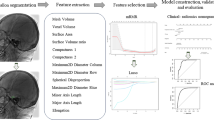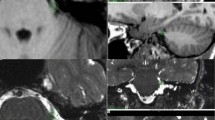Abstract
Because of its convenience and safety, percutaneous balloon compression (PBC) has become a more popular remedy for trigeminal neuralgia (TN) recently. The objective of this study was to establish a nomogram that can be used to preoperatively prognosticate the likelihood of pain-free based on preoperative disease characteristics. Clinical data were collected from those TN cases who had undergone PBC during the period of 2015 and 2020 in Qingdao Municipal Hospital. We excluded the cases caused by space-occupying lesion or had undergone MVD, percutaneous glycerol rhizotomy (PGR), and glycerol rhizotomy (GR). A nomogram was established based on the results of multivariable logistic analysis. A receiver operating characteristic curve (ROC) analysis was applied to evaluate the reliability of models. The plotted decision curves were also used to assess the net benefit of nomogram-assisted decisions. Internal validation was performed using the ROC by bootstrap sampling. Finally, 16 cases and 69 cases were included into the ineffective and effective groups respectively. In the crude, adjust I and adjust II models, response to carbamazepine positively, the grade II or III compression severity score, and classical TN type were all considered to be significant predictors of pain relief (BNI grades I–III) at 3 months’ follow-up. The AUC, accuracy, specificity, and sensitivity of the nomogram system were 0.83, 0.85, 0.75, and 0.87 respectively for predicting patient outcomes. The decision curves showed good performance for the nomogram system in terms of clinical application, while more research with validation in multiple, external independent patient populations is needed.




Similar content being viewed by others
Data Availability (data transparency)
Not applicable
Code availability (software application or custom code)
Data were analyzed with the use of the statistical packages R (The R Foundation; http://www.r-project.org; version 3.4.3) and Empower (R) (www.empowerstats.com, X&Y solutions, Inc., Boston, MA).
References
Abdennebi B, Guenane L (2014) Technical considerations and outcome assessment in retrogasserian balloon compression for treatment of trigeminal neuralgia. Series of 901 patients. Surg Neurol Int 5:118. https://doi.org/10.4103/2152-7806.137838
Agarwal A, Dhama V, Manik YK, Upadhyaya MK, Singh CS, Rastogi V (2015) Percutaneous balloon compression of gasserian ganglion for the treatment of trigeminal neuralgia: an experience from India. Middle East J Anaesthesiol 23:105–110
Asplund P, Linderoth B, Bergenheim AT (2010) The predictive power of balloon shape and change of sensory functions on outcome of percutaneous balloon compression for trigeminal neuralgia. J Neurosurg 113:498–507. https://doi.org/10.3171/2010.2.jns091466
Asplund P, Linderoth B, Lind G, Winter J, Bergenheim AT (2019) One hundred eleven percutaneous balloon compressions for trigeminal neuralgia in a cohort of 66 patients with multiple sclerosis. Oper Neurosurg (Hagerstown, Md) 17:452–459. https://doi.org/10.1093/ons/opy402
Bendtsen L, Zakrzewska JM, Heinskou TB, Hodaie M, Leal PRL, Nurmikko T, Obermann M, Cruccu G, Maarbjerg S (2020) Advances in diagnosis, classification, pathophysiology, and management of trigeminal neuralgia. Lancet Neurol 19:784–796. https://doi.org/10.1016/s1474-4422(20)30233-7
Bergenheim AT, Asplund P, Linderoth B (2013) Percutaneous retrogasserian balloon compression for trigeminal neuralgia: review of critical technical details and outcomes. World Neurosurg 79:359–368. https://doi.org/10.1016/j.wneu.2012.03.014
Brown JA, Gouda JJ (1997) Percutaneous balloon compression of the trigeminal nerve. Neurosurg Clin N Am 8:53–62
Cote DJ, Dasenbrock HH, Gormley WB, Smith TR, Dunn IF (2019) Adverse events after microvascular decompression: a national surgical quality improvement program analysis. World Neurosurg 128:e884–e894. https://doi.org/10.1016/j.wneu.2019.05.022
Du Y, Yang D, Dong X, Du Q, Wang H, Yu W (2015) Percutaneous balloon compression (PBC) of trigeminal ganglion for recurrent trigeminal neuralgia after microvascular decompression (MVD). Ir J Med Sci 184:745–751. https://doi.org/10.1007/s11845-014-1163-7
Gambeta E, Chichorro JG, Zamponi GW (2020) Trigeminal neuralgia: an overview from pathophysiology to pharmacological treatments. Mol Pain 16:1744806920901890. https://doi.org/10.1177/1744806920901890
Greve T, Tonn JC, Mehrkens JH (2020) Microvascular decompression for trigeminal neuralgia in the elderly: efficacy and safety. J Neurol 268:532–540. https://doi.org/10.1007/s00415-020-10187-w
Hardaway FA, Gustafsson HC, Holste K, Burchiel KJ, Raslan AM (2019) A novel scoring system as a preoperative predictor for pain-free survival after microsurgery for trigeminal neuralgia. J Neurosurg 132:1–8. https://doi.org/10.3171/2018.9.jns181208
Headache Classification Committee of the International Headache Society (IHS) The International Classification of Headache Disorders, 3rd edition (2018). Cephalalgia 38:1-211. https://doi.org/10.1177/0333102417738202
Holste K, Chan AY, Rolston JD, Englot DJ (2020) Pain outcomes following microvascular decompression for drug-resistant trigeminal neuralgia: a systematic review and meta-analysis. Neurosurgery 86:182–190. https://doi.org/10.1093/neuros/nyz075
Jani RH, Hughes MA, Gold MS, Branstetter BF, Ligus ZE, Sekula RF Jr (2019) Trigeminal nerve compression without trigeminal neuralgia: intraoperative vs imaging evidence. Neurosurgery 84:60–65. https://doi.org/10.1093/neuros/nyx636
Kouzounias K, Schechtmann G, Lind G, Winter J, Linderoth B (2010) Factors that influence outcome of percutaneous balloon compression in the treatment of trigeminal neuralgia. Neurosurgery 67:925–934; discussion 934. https://doi.org/10.1227/NEU.0b013e3181eb5230
Li F, Han S, Ma Y, Yi F, Xu X, Liu Y (2014) Optimal duration of percutaneous microballoon compression for treatment of trigeminal nerve injury. Neural Regen Res 9:179–189. https://doi.org/10.4103/1673-5374.125347
Li MW, Jiang XF, Niu CS (2020) Efficacy of and risk factors for percutaneous balloon compression for trigeminal neuralgia in elderly patients. Br J Neurosurg:1–5. https://doi.org/10.1080/02688697.2020.1787341
Lichtor T, Mullan JF (1990) A 10-year follow-up review of percutaneous microcompression of the trigeminal ganglion. J Neurosurg 72:49–54. https://doi.org/10.3171/jns.1990.72.1.0049
Mullan S, Lichtor T (1983) Percutaneous microcompression of the trigeminal ganglion for trigeminal neuralgia. J Neurosurg 59:1007–1012. https://doi.org/10.3171/jns.1983.59.6.1007
Ni H, Wang Y, Chen X, Gu W (2020) Outcomes of treatment for elderly patients with trigeminal neuralgia: percutaneous balloon compression versus microvascular decompression. J Craniofac Surg 31:e685–e688. https://doi.org/10.1097/scs.0000000000006544
Panczykowski DM, Jani RH, Hughes MA, Sekula RF (2019) Development and evaluation of a preoperative trigeminal neuralgia scoring system to predict long-term outcome following microvascular decompression. Neurosurgery. 87:71–79. https://doi.org/10.1093/neuros/nyz376
Rughani AI, Dumont TM, Lin CT, Tranmer BI, Horgan MA (2011) Safety of microvascular decompression for trigeminal neuralgia in the elderly. Clinical article. J Neurosurg 115:202–209. https://doi.org/10.3171/2011.4.jns101924
Stomal-Słowińska M, Słowiński J, Lee TK, Uitti RJ, Deen HG, Reimer R, Cheshire WP Jr, Herzog-Bryan G, Wharen RE Jr (2011) Correlation of clinical findings and results of percutaneous balloon compression for patients with trigeminal neuralgia. Clin Neurol Neurosurg 113:14–21. https://doi.org/10.1016/j.clineuro.2010.08.005
Texakalidis P, Xenos D, Tora MS, Wetzel JS, Boulis NM (2019) Comparative safety and efficacy of percutaneous approaches for the treatment of trigeminal neuralgia: a systematic review and meta-analysis. Clin Neurol Neurosurg 182:112–122. https://doi.org/10.1016/j.clineuro.2019.05.011
Tyler-Kabara EC, Kassam AB, Horowitz MH, Urgo L, Hadjipanayis C, Levy EI, Chang YF (2002) Predictors of outcome in surgically managed patients with typical and atypical trigeminal neuralgia: comparison of results following microvascular decompression. J Neurosurg 96:527–531. https://doi.org/10.3171/jns.2002.96.3.0527
Xia L, Liu MX, Zhong J, Dou NN, Li B, Sun H, Li ST (2017) Fatal complications following microvascular decompression: could it be avoided and salvaged? Neurosurg Rev 40:389–396. https://doi.org/10.1007/s10143-016-0791-y
Xu W, Jiang C, Yu C, Liang W (2018) Percutaneous balloon compression for persistent or recurrent trigeminal neuralgia after microvascular decompression: personal experience of 28 patients. Acta Neurol Belg 118:561–566. https://doi.org/10.1007/s13760-017-0858-8
Zhang WB, Zeng YY, Chang BW, Min LZ, Sun QY, Bin L, Tao BB, Wang XQ (2020) Prognostic nomogram for microvascular decompression-treated trigeminal neuralgia. Neurosurg Rev 44:571–577. https://doi.org/10.1007/s10143-020-01251-0
Funding
This work was supported by the China’s government under grant of National Natural Science Foundation (#82001184).
Author information
Authors and Affiliations
Contributions
All authors take responsibility for the integrity and the accuracy of this manuscript. Study concept and design: WW and LL; draft of the manuscript: ML, ST, and TL; acquisition of data: YZ and SL; statistical analysis: ZX; edit: WW; revised: JS and WS.
Corresponding authors
Ethics declarations
Ethics approval (include appropriate approvals or waivers)
Not applicable
Consent to participate (include appropriate statements)
Not applicable
Consent for publication (include appropriate statements)
Not applicable
Conflict of interest (include appropriate disclosures)
The authors declare no competing interests.
Additional information
Publisher’s note
Springer Nature remains neutral with regard to jurisdictional claims in published maps and institutional affiliations.
Rights and permissions
About this article
Cite this article
Liu, M., Tang, S., Li, T. et al. Prognostic nomogram for percutaneous balloon compression in the treatment of trigeminal neuralgia. Neurosurg Rev 45, 561–569 (2022). https://doi.org/10.1007/s10143-021-01514-4
Received:
Revised:
Accepted:
Published:
Issue Date:
DOI: https://doi.org/10.1007/s10143-021-01514-4




